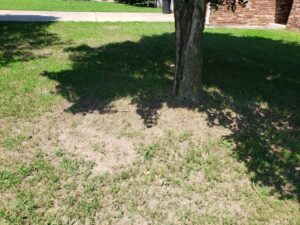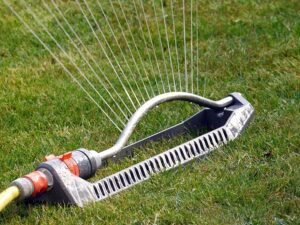DIY Topsoil and Lawn Patching
Does your lawn look like the picture above? Do you want to know how to fix it yourself? Many lawns here in Oklahoma start to look just like this over time and happen because of many factors. For example, Oklahoma is known to have many weather shifts from hot to cold and dry to wet. The type of grass in your lawn and how long any particular weather lasts are factors that can put some stress on your lawn.

So how do you fix these spots?
The example photo on the left shows bare spots below a tree. One of the main reasons this happens is because the grass below is not a blend that thrives in a cool or shaded area. If you think about it, when a yard has sod installed, the sod is generally grown from a mix tolerant to high temperatures and direct sun. Sod is not grown under trees. Therefore, planting a bush or tree can cause that type of grass to die off.
To fix these issues, and most patchy lawn issues, you want to start overseeding your lawn with a mix of seed designed for that environment.
Do I need topsoil?
A good seed blend isn’t the only thing needed to fix a lawn like this. Trees showing roots are a good indicator that you don’t have a good foundation for new grass to grow. Oklahoma is known for clay soil . Therefore, getting a new topsoil down is a key factor for getting new seeds to germinate. There are many different types of topsoil available. Be sure to read what they are best for as well as reviews. For example, some topsoil options may have a moisture barrier additive or a starter fertilizer mixed in. With bare spots, we always include about 4 inches of topsoil. This allows new seeds to have a good root foundation to latch on to.
How should I water it?
For us, we recommend at least 1 hour a day for roughly 10 days and before noon when the sun is the hottest. The easiest way to accomplish this is to use a sprinkler system. However, this is just a base example. Depending on your region, you may need to water more or less. Likewise, the seeds you spread may tell you something different for best results.

DIY Topsoil and Lawn Patching Checklist
- Determine common issues that lead to bare spots
- Find the best grass blend for those issues
- Make sure topsoil used is for lawns and not potting plants
- Calculate about 3 to 4 inches of topsoil
- Follow a consistent watering method
- Reapply seeds in area s 2 to 3 times
In Conclusion
Patching a lawn isn’t a difficult process. It just takes a little time and you can get your lawn into shape. However, if you would rather have us do it for you, contact us for your free quote.

